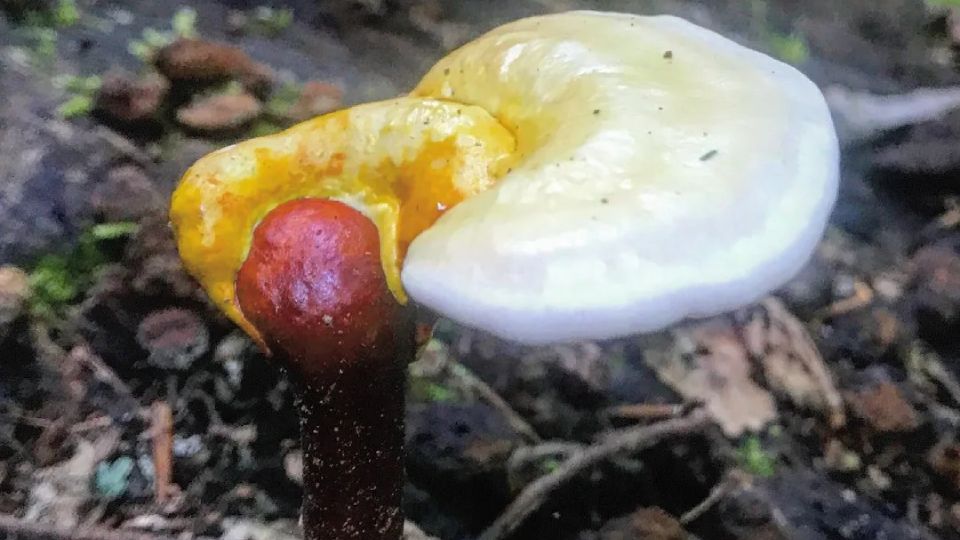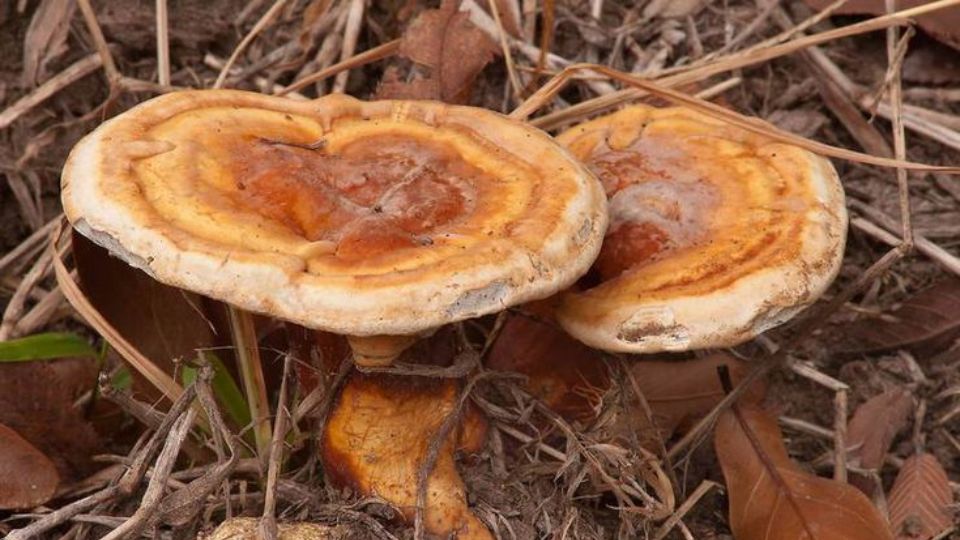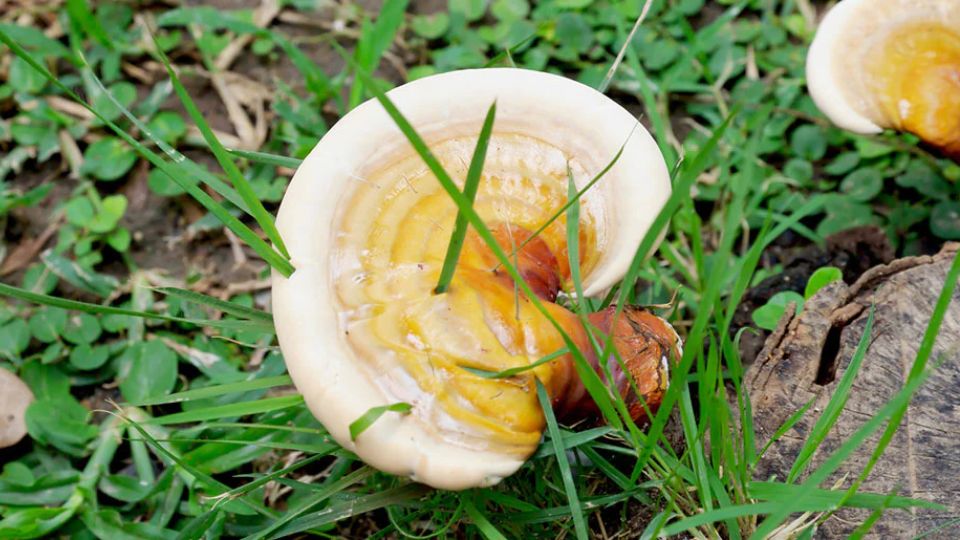Ganoderma Curtisii (Golden Reishi): Identification, Benefits, and Uses
Ganoderma curtisii is a captivating mushroom that has fascinated mycologists and enthusiasts around the globe. Its name “Ganoderma” refers to its shiny or lustrous skin, while “curtisii” pays tribute to Moses Ashley Curtis, an American Episcopal priest, teacher, botanist, and mycologist who lived from 1808-1872. This mushroom holds immense potential due to its distinctive appearance, varied habitats, and widespread distribution. In this comprehensive article, we will explore the intriguing aspects of G. curtisii, including its traditional uses, benefits, identification techniques, side effects, and more.
In this article:
What is Ganoderma curtisii?
Ganoderma curtisii, also known as “Golden Reishi” or “Yellow Reishi”, is a type of wood-decaying polypore that can primarily be found in the southeastern United States. It was first described by Miles Berkeley in 1849 under the name Polyporus curtisii. Later, in 1908, William Alphonso Murrill reclassified it into the genus Ganoderma. However, there is still ongoing debate about whether it should be considered a distinct species separate from North American specimens described as Ganoderma lucidum (also known as G. sessile), which has a broader distribution across the US. Furthermore, there are ongoing discussions regarding the identities of various species that resemble both G. lucidum and G. tsugae.
Interestingly, Golden Reishi can sometimes infest injured living trees. It produces fruiting bodies annually, and in warmer climates, it has the ability to bear fruit at any time throughout the year. While it is important to note that this mushroom is inedible, it does possess potential benefits worth exploring.
Traditional Uses

Throughout history, Ganoderma curtisii has held a significant place in various cultures, they have a long history of use in China, Japan, and other Asian countries to promote health and longevity. In Eastern traditional medicine, practitioners prescribe them as a preventive and immune-enhancing treatment, known for their anti-inflammatory properties. Supplements made from Ganoderma are increasingly used as a natural way to support blood pressure, immune response, inflammatory response, sleep quality, respiratory health, and more.
Golden Reishi is considered inedible and is primarily used for medicinal purposes rather than as a culinary ingredient. Consuming raw mushrooms can be potentially harmful and difficult for our digestive system to break down.
While powdered extracts and supplements are commonly available for convenient consumption, there are other ways to incorporate Golden Reishi into your diet.
One popular method is making a decoction or tea from dried Golden Reishi slices. You can simmer the slices in water for an extended period to extract the beneficial compounds. Another option is adding dried or powdered Golden Reishi to soups, stews, or broths to enhance their flavor and potentially reap some of the medicinal benefits[1].
Ganoderma Curtisii Identification
Accurately identifying Ganoderma curtisii is crucial, given its resemblance to other mushroom species. This mushroom typically displays a bright white to yellow pore surface, distinguishing it from similar species like Ganoderma lucidum. Its fruiting bodies possess a bracket-like structure that grows horizontally on trees.
- Cap: This mushroom’s cap has a medium to large size and takes on a semi-circular or kidney-shaped form. Its upper surface is hard and exhibits a lacquer-like texture. You can observe concentric zones of yellow, white, and brown on the cap.
- Flesh: The flesh of this mushroom appears pale brown and is marked by melanoid bands. However, it does not possess concentric growth zones.
- Lateral stem: Typically, this mushroom features a fairly well-developed lateral stem. However, it’s important to note that there are instances where the lateral stem may be absent.
- Spores: When you examine the spores of this mushroom under a microscope, you will find that they measure 9–11.5 µm in length.
Understanding the key characteristics and distinguishing features is vital to correctly identifying Ganoderma curtisii in its natural habitat[2].
It’s worth mentioning that there is an ongoing debate regarding the identities of several species that resemble G. lucidum and G. tsugae. Additionally, the classification of G. curtisii as a distinct species from North American specimens described as G. lucidum (G. sessile) is a topic of debate.
Ganoderma Curtisii Benefits
Although there is some research on the health benefits of other Ganoderma species like Ganoderma lucidum (reishi mushroom), there is limited scientific evidence specifically focusing on the health benefits of Ganoderma curtisii.
People in East Asia have traditionally used Ganoderma species, including G. curtisii, in various forms of traditional medicine for their potential health-promoting properties. They often consume them as dietary supplements, extracts, or teas.
It’s important to note that scientific studies have mainly concentrated on Ganoderma lucidum. These studies suggest that Ganoderma lucidum may have potential health benefits, such as boosting the immune system, reducing inflammation, supporting liver function, and acting as an antioxidant.
G. curtisii may hold similar promise, but the extent of its medicinal value remains unknown. Future research could shed light on its potential benefits[3].
Due to the limited specific research on G. curtisii, it’s challenging to make definite claims about its health benefits. If you’re considering using them or any other herbal supplement for health purposes, it’s advisable to consult with a healthcare professional. They can provide personalized advice based on your specific health needs and medical history.
Medical Compounds
Here’s a table summarizing the medical compounds found in Ganoderma curtisii:
| Medical Compounds | Description and Potential Effects |
| Triterpenoids | Believed to have immune-modulating and anti-inflammatory properties. |
| Polysaccharides | May exhibit antioxidant activity and contribute to immune support. |
| Peptides | Potential bioactive substances with various therapeutic properties. |
| Other Bioactive Substances | Additional compounds with potential health benefits that require further research. |
Please note that this table provides a general overview of the medical compounds in Ganoderma curtisii, and further research is needed to fully understand their mechanisms and potential applications.
Cultivation and Harvesting

If you’re interested in cultivating and harvesting Ganoderma curtisii, here are some key points to keep in mind:
- Natural Habitat: Ganoderma curtisii is commonly found growing on dead hardwood logs, especially oak or maple. Occasionally, it can be found on other hardwoods as well.
- Cultivation: While cultivating Ganoderma curtisii is not as common as other species like Ganoderma lucidum, it’s still possible. To recreate its natural habitat, you’ll need to provide a suitable substrate, such as hardwood logs. Maintain proper temperature, humidity levels, and ensure good air circulation.
- Harvesting: When it’s time to harvest Ganoderma curtisii, wait until the mushroom has fully matured. The cap initially has a vibrant ochre color but dulls as it ages. The cap will have a matte finish instead of a shiny appearance. To harvest, use a sharp knife or saw to carefully cut the mushroom at the base, leaving a portion of the stem attached to the log. This allows for potential regrowth of the mushroom.
Remember, cultivating and harvesting mushrooms require attention to detail and adherence to their specific growth conditions.
How to Use Ganoderma curtisii
Ganoderma curtisii isn’t usually eaten raw due to its tough and woody texture. However, there are other ways you can enjoy its potential health benefits. Let me share a few examples with you:
First, you can make a delicious Ganoderma tea by simmering sliced or powdered Ganoderma curtisii in hot water for about 30 minutes. After that, simply strain the liquid and enjoy a soothing cup of herbal tea. If you prefer a sweeter taste, feel free to add honey or other natural sweeteners.
Another option is to try powdered supplements. You can easily find G. curtisii in powdered form at health food stores or online. Just follow the recommended dosage instructions provided by the manufacturer. You can mix the powder into your favorite beverages like smoothies or juices, or even sprinkle it over your food for an extra nutritional boost.
If you’re looking for a convenient way to incorporate them into your routine, consider trying capsules. These capsules provide an easy and hassle-free method of consuming this mushroom. Just follow the instructions on the packaging to determine the appropriate dosage for you.
For those interested in making tinctures, Ganoderma curtisii can be used in that form as well. To make a tincture, you’ll need to soak dried mushrooms in alcohol, such as vodka or rum, for several weeks. The alcohol helps extract the medicinal compounds from the mushroom. Once the soaking period is over, strain the liquid and store it in a dark glass bottle. You can then add a few drops of the tincture to a glass of water or another beverage to enjoy its benefits[4].
REMEMBER
It’s always a good idea to consult with a healthcare professional before adding any new supplements to your diet, especially if you have underlying health conditions or are taking medications.
Ganoderma curtisii Dosage
Determining the appropriate dosage of Ganoderma curtisii is crucial for maximizing its benefits while ensuring safety. As with any natural remedy, it is essential to consult with a healthcare professional or a trained mycologist to establish the correct dosage based on individual needs and circumstances. Factors such as age, overall health, and existing medical conditions should be taken into consideration when determining the suitable dosage of G. curtisii.
Ganoderma curtisii Toxicity, Safety & Side Effects
When using Ganoderma curtisii or similar mushrooms, it’s important to be aware of potential side effects, although their exact frequency is not well-known. These side effects may include dryness and itchiness in the mouth, throat, and nasal areas, nosebleeds, nausea. Some people may also experience rashes from consuming reishi. Additionally, allergic reactions to the spores can occur, although this is not uncommon with many mushrooms. It’s worth noting that there is limited evidence suggesting that certain reishi products may have a negative impact on the liver, although this has not been confirmed.
Reishi mushrooms, including Ganoderma curtisii, have the potential to lower blood pressure and reduce blood clotting, which can be beneficial for some individuals. However, this could pose risks for those with already low blood pressure, a clotting disorder, individuals taking medications with similar effects, or those preparing for surgery.
It’s essential to understand that while recognized medications also have their own risks and side effects, the potential benefits and risks of products derived from these fungi should be carefully considered by a qualified healthcare practitioner.
The main concern lies in the fact that there is currently no specific research available on the risks and dangers associated with Ganoderma curtisii. Therefore, it’s crucial to approach the use of this mushroom with caution and seek guidance from a healthcare professional.
Future Research
The potential for future research on Ganoderma curtisii is vast, offering numerous avenues for exploration and discovery. Areas that warrant further investigation include its mechanisms of action, potential applications in various medical fields, and the optimization of cultivation techniques. As scientists continue to unravel the mysteries of G. curtisii, new insights and breakthroughs are likely to emerge, further solidifying its place in traditional medicine and modern research.
FAQs
When to Pick Ganoderma Curtisii?
Ganoderma curtisii mushrooms are best picked when they are still in the early stages of growth, typically when they are young and tender. This is when they are at their peak for culinary use and have a softer texture, making them more enjoyable to eat. They are often found in the wild during the late summer and early fall.
What is Ganoderma Good For?
Ganoderma, particularly Ganoderma lucidum (Reishi), is believed to have various potential health benefits. It’s thought to support the immune system, reduce inflammation, and improve overall well-being. However, scientific evidence varies, so consult a healthcare provider before using it as a treatment for specific health issues.
How to Prepare Ganoderma Curtisii?
To prepare Ganoderma curtisii, you can make tea by simmering sliced or powdered mushrooms in hot water for around 30 minutes. Strain the liquid and enjoy it as a herbal tea. You can also find it in powdered or capsule form for easy consumption.
What Does Golden Reishi Look Like?
Golden Reishi, also known as Ganoderma curtisii, has a distinct appearance. It has a fan-shaped or semicircular cap with a reddish-brown color. The upper surface is smooth and shiny, while the underside typically has tiny, round pores instead of gills.
Conclusion
In conclusion, Ganoderma curtisii stands as a remarkable mushroom with immense potential in traditional medicine and beyond. Its unique physical appearance, historical significance, traditional uses, and medicinal properties make it a subject of great interest and intrigue. As we continue to explore the possibilities offered by Ganoderma curtisii, it is crucial to approach it with scientific rigor, respect for traditional knowledge, and an open mind to uncover the secrets hidden within this captivating species.
References
1. ANTIMICROBIAL ACTIVITY PRESENT IN Ganoderma curtisii AQUEOUS EXTRACTS. Retrieved from https://www.researchgate.net/publication/342254302_ANTIMICROBIAL_ACTIVITY_PRESENT_IN_Ganoderma_curtisii_AQUEOUS_EXTRACTS
2. Evaluation of the Use of Elicitors for the Production of Antioxidant Compounds in Liquid Cultures of Ganoderma curtisii from Costa Rica. Retrieved from https://www.researchgate.net/publication/361777162_Evaluation_of_the_Use_of_Elicitors_for_the_Production_of_Antioxidant_Compounds_in_Liquid_Cultures_of_Ganoderma_curtisii_from_Costa_Rica
3. Species clarification of the prize medicinal Ganoderma mushroom “Lingzhi”. Retrieved from https://www.researchgate.net/publication/257799879_Species_clarification_of_the_prize_medicinal_Ganoderma_mushroom_Lingzhi
4. Distinguishing the Many ” Faces ” of ‘G. lucidum’ in the Eastern United States: a challenging taxonomic task. Retrieved from https://www.researchgate.net/publication/318753744_Distinguishing_the_Many_Faces_of_%27G_lucidum%27_in_the_Eastern_United_States_a_challenging_taxonomic_task

